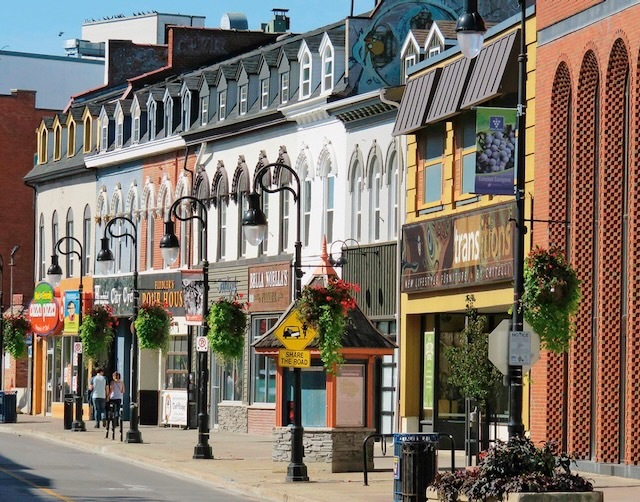St. Catharines Rents Jump While House Prices Tumble

The St. Catharines housing market holds good and bad for newcomers to Canada and international students.
The good news for immigrants hoping to buy quickly after landing is that housing prices are falling due to recent interest rate hikes designed to curb inflation.
The bad news for those looking to rent is that rent prices are rising, just as they are across the country. And the vacancy rate is low.
Record number of newcomers expected
For 2022, Canada could meet or even exceed its target of 431,000 new immigrants in 2022 if recent trends continue, according to data from the Immigration, Refugee and Citizenship Canada (IRCC).
The previous record was set in 2021.
So far, most newcomers to Canada have come from India. Ontario remains the top landing spot for new immigrants.
According to the latest Zumper rental report, the average rent for a 1-bedroom apartment in downtown St. Catharines is currently $1,832. This is a 13 percent increase compared to the previous year.
St. Catharines is the 11th most expensive rental market
Over the past month, the average rent for a studio apartment in downtown St. Catharines increased by 2 percent to $1,425. The average rent for a 1-bedroom apartment increased by 5 percent to $1,832, and the average rent for a 2-bedroom apartment increased by 9 percent to $2,149.
Based on the August report, St. Catharines remains the eleventh most expensive rental market in all of Canada.
A recent St. Catharines Standard story by Matthew P. Barker pointed out that with about 16,944 rental units reported in the region by Canada Housing and Mortgage Corp., the Niagara Region had a vacancy rate of less than two percent.
With the provincial vacancy rate average at 3.4 percent, Niagara has one of the lowest rates in the province for its population size. Similarly, Guelph, Oshawa and Whitby are at about 1.9 percent.
We know the vacancy rate for bachelors and affordable one-bedroom units is close to zero - Jeff Sinclair, Niagara Region
The Niagara region is seeing a dire need for more one-bedroom apartments because those are the least available in the area, Jeffrey Sinclair, housing and homelessness action plan adviser for Niagara Region, told The Standard.
“We know the vacancy rate for bachelors and affordable one-bedroom units is close to zero,” he said.
Greater competition favours the market
“If vacancy rates are low, then you’re competing with more people for each unit, so it’s harder to get units or have a successful interview with the landlord, so greater competition favours the market (as) opposed to individuals trying to get access in it.”
The latest Canadian Rent Report from Zumper said prices of one and two bedrooms in the Garden City are renting for medians of $1,550 and $1,800, respectively.
Most affordable neighbourhoods
Also, according to Zumper, the most affordable neighborhoods in St. Catharines are Queenston, where the average rent can go for $1,599 a month, Fairview - Facer, where the average rent can go for $1,695 a month, and Glenridge, where the average rent can go for $1,740 a month.
The most expensive neighborhoods in St. Catharines are Western Hill, where the average rent can go for $2,100 a month, Lakeport, where the average rent can go for $1,950 a month, and Downtown St. Catharines, where the average rent can go for $1,949 a month.
The most popular Neighborhoods in St. Catharines are Grantham, Downtown St. Catharines, followed by York - Haig with 18 places.
The latest Zumper report also lists these cities as the Top 5 Most Expensive Canadian rental markets:
1 - Vancouver, BC, was the most expensive Canadian city with one-bedroom rent climbing 4.3% to $2,400, while two-bedrooms grew 4.2% to $3,440. Notably, both one and two-bedroom rents are up about 20% since this time last year.
2 - Toronto, ON ranked as the 2nd priciest market with one-bedroom rent falling 4.8% to $2,000, while two-bedrooms dropped 5.9% to $2,540.
3 - Victoria, BC moved up a spot to become 3rd with one-bedroom rent jumping 5.9% to $1,990. Two-bedrooms were up significantly as well, climbing 5.5% to $2,480.
4 - Burnaby, BC dropped a position to rank as the 4th most expensive with one-bedroom rent falling 5.8% to $1,940, while two-bedrooms decreased 4% to $2,640.
5 - Oshawa, ON rounded off the top 5 markets with one-bedroom rent growing 3.6% to $1,750, while two-bedrooms remained flat at $2,000.
Housing prices in Niagara are falling
Meanwhile, according to the latest data from CREA and the Niagara Association of Realtors, the number of homes sold in July was 413 units, down sharply by 51 percent from July 2021.
The NAR represents more than 1,500 realtors selling in the Niagara Region communities of Fort Erie, Fonthill/Pelham, Lincoln, Niagara Falls, Niagara-on-the-lake, and Port Colborne/Wainfleet, St Catharines, Thorold and Welland.
Home sales were 45.6% below the five-year average and 44.7% below the 10-year average for the month of July.
On a year-to-date basis, home sales totalled 4,518 units over the first seven months of the year. This was a substantial decline of 30.7% from the same period in 2021.
CREA tracks price trends far more accurately than is possible using average or median price measures. The overall composite benchmark price was $716,500 in July 2022, a gain of 9.6 percent compared to July 2021.
The benchmark price for single-family homes was $730,900, up by 9.2 percent on a year-over-year basis in July. By comparison, the benchmark price for townhouse/row units was $674,000, an increase of 15.4 percent compared to a year earlier, while the benchmark apartment price was $497,400, a sizable gain of 17.1 percent from year-ago levels.
The average price of homes sold in July 2022 was $732,568, a small gain of 2.3 percent from July 2021.
The more comprehensive year-to-date average price was $832,174, increasing by 20 percent from the first seven months of 2021.
The dollar value of all home sales in July 2022 was $302.6 million, a sharp decrease of 49.8 percent from the same month in 2021.
The number of new listings was up by 19 percent from July 2021. There were 1,298 new residential listings in July 2022.
New listings were 6.3 percent above the five-year average and 14.6% above the 10-year average for the month of July.
Active residential listings numbered 2,201 units on the market at the end of July, more than double the levels from a year earlier, jumping 127.1 percent from the end of July 2021.
Active listings were 20.2 percent above the five-year average and 7.3% above the 10-year average for the month of July.
Months of inventory numbered 5.3 at the end of July 2022, up from the 1.2 months recorded at the end of July 2021 and above the long-run average of 3 months for this time of year. The number of months of inventory is the number of months it would take to sell current inventories at the current rate of sales activity.

